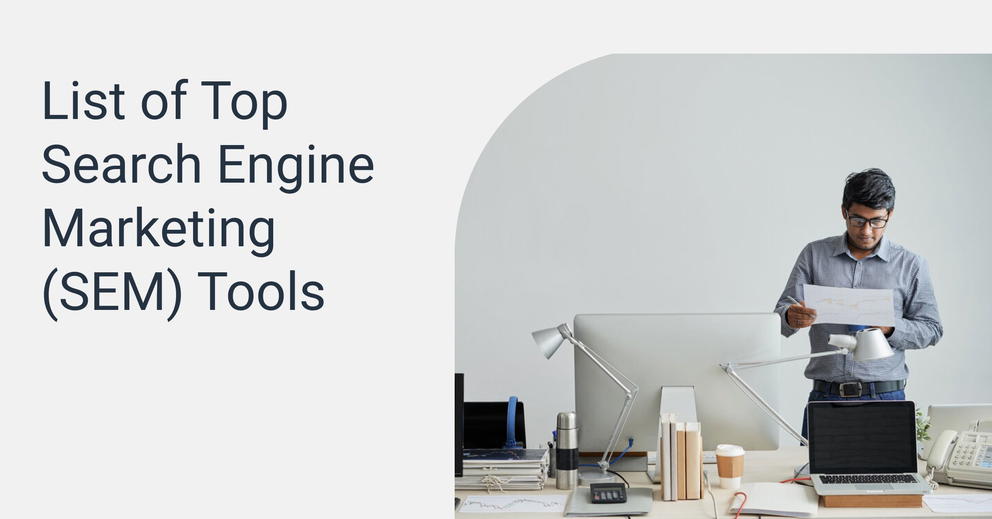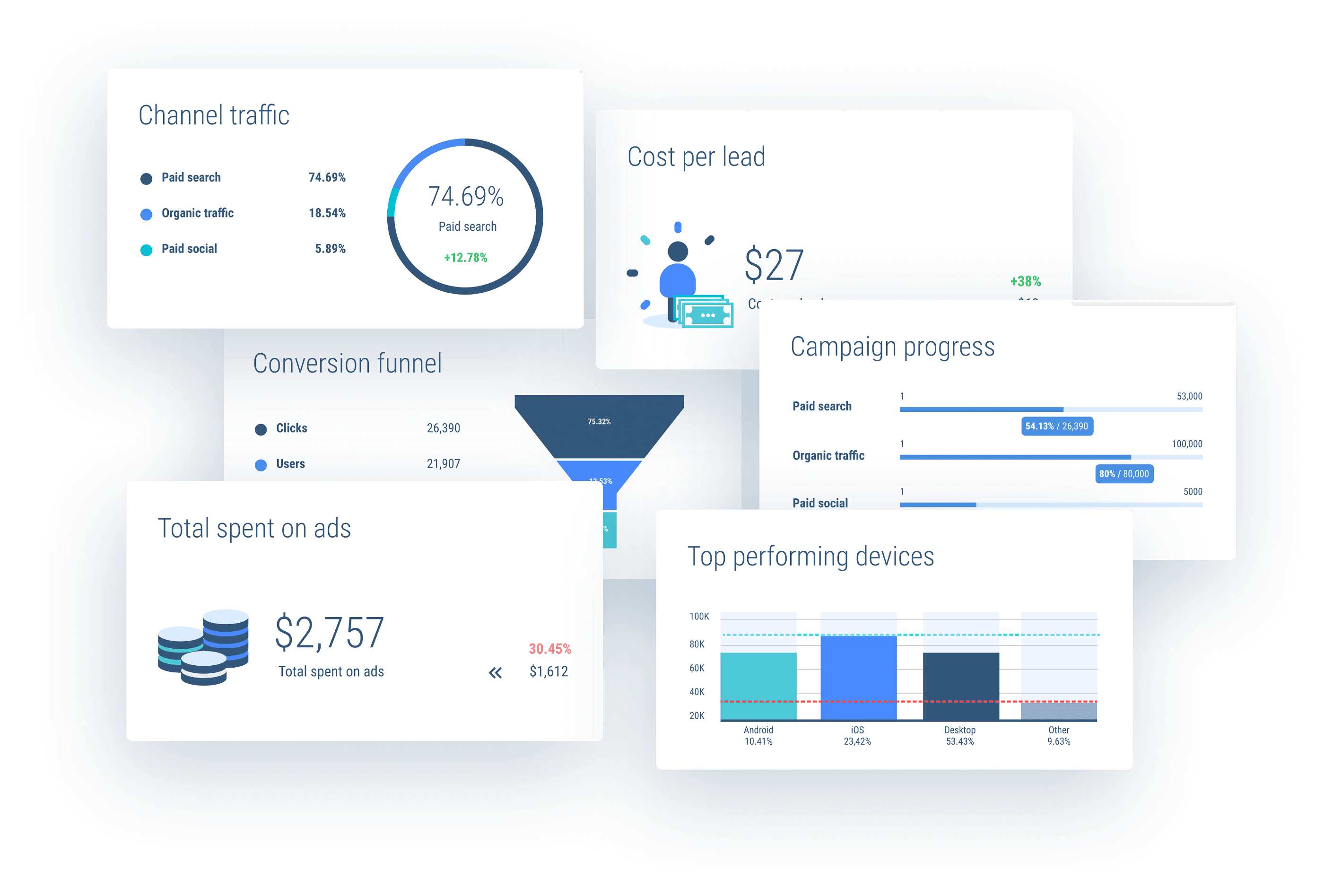The main types of SEM tools
Whether it be SEO, local search tools, or paid per click ads, using these SEM tools can take your campaigns to the next level.

Oct 26 2020●8 min read

What is SEM?
What exactly is search engine marketing (SEM), how does it work, and what are the main types of SEM tools? To break it down, search engine marketing, in a broad stroke of the brush, means using paid advertisements, organic searches, or local searches to appear on search engine results pages (SERPs).
The first things that probably come to your mind are - keyword planning, Google Ads, and Google analytics.
Well, you wouldn't be wrong if you associate SEM with these things because they go hand-in-hand. Much of what SEM is about is related to search engines such as Google, Bing, Yahoo, and others that people know much less about.
What tools are under the SEM umbrella?
While many people often refer to SEM as exclusively a paid version of marketing, it encompasses more than pay per click ads. Search engine marketing more accurately covers organic search engine optimization (SEO), local search, and paid search. For the sake of covering all bases and not being too main-stream, we will go over SEO, local search, and paid search. It is also important to do the right reporting on search queries.
As with just about everything else in marketing - terms get bunched together with different items, making things messy when trying to define terminology. Search Engine Marketing is not categorized as a single action or strategy - even with many people wishing it would be. There are different ways to implement a SEM strategy, and depending on your needs, different tools at your disposal.
And in a world full of competition and an ever-expanding worldwide web of gurus and digital marketing experts, using the right tools can help you get the upper-hand on the competition with your Google Ads campaigns or social media campaigns. So, if the right tools are what you are looking for to do just that - look no further. We have also covered SEO tools for agencies to make work with clients easier.
This all sounds like it could help you get ahead of the competition if done correctly, right?
Well, yes and no.
Done the right way, and with all of the wherewithal, you could really leapfrog a lot of the competition, but first and foremost, you have to know what tools are out there to use in SEM and which one(s) would be the best for you.
Main types of SEM
Organic Search Engine Optimization
Tools | About | Features | Free Trials | Price |
| Semrush | Online advertising, social media, SEO, and content creation tool. | Keyword researches; Domain metrics; Content analytics; | 7-days | Pro: $99.95/month. Guru: $199.95/month. Business: $399.95/month. |
| SurferSEO | SEO and content creation. | Strong content analyze; Keyword researches; | 7-day money-back guarantee | Free: $0/month. Basic: $49/month. Pro: $99/month. Business: $199/month. |
| Hunter | Outreach management | Domain search; Email finder; | Free (limited) | Starter: €49/month. Growth:€99/month. Pro: €199/month. Enterprise: €399/month. |
The first SEM tool we're going to examine is organic SEO. Others are known by many as the free tool to get your business known. But on a more serious note... SEO, at this point, is most definitely a buzzphrase. We've all heard it, but few of us know what it means in-depth.
Without rocking you to sleep with the nitty-gritty details of backlinks, keyword research, auditing, keyword rankings, and all of that good stuff, organic SEO is the optimization process that enables you to be more visible in unpaid and non-local results on SERPs. As you may have guessed, this comes at no cost when people click on your page from SERPs.
You're probably wondering... How is this possible?
There are actually over 200 factors that influence this ranking system. Your website architecture, your content, backlinks that lead back to your site from other reputable sites, and your competition all have roles to play in your ranking on SERPs.
Normally, organic results show up somewhere in the middle of SERPs, between the paid search results and lower than the relevant local search terms.
The timeline of being listed typically depends on how well your SEO is done, but you could begin seeing your content display in organic search results in 4 to 6 months.
According to most research, organic is considered by most to be the most trustworthy while also earning the most clicks. Organic results also allow you to display many different search terms with flexibility. These results will also compound over time if maintained and achieved through proper methods.
Organic SEO is particularly useful for most cost-sensitive companies and those trying to minimize expenses while aiming to perform well with search engines for marketing.
Local Search
Tools | About | Features | Free Trials | Price |
| Moz Local | SEO tool for local needs. | Local listing; Review Monitoring; Instant directory submission; | Free (limited) | Pro: $129/year. Guru: $179/month. Business: $299/month. |
| BrightLocal | SEO tool for local needs. | Monitor existing citations; | 7-days | Basic: $49.2/month. Pro: $82.5/month. Business: $165.8/month. |
The next tool under examination is local search. Local search is also a type of search engine optimization. This one, as you have already guessed, focuses on getting your business to show up as local results on SERPs, whether it be Google, Bing, or Yahoo.
These results most often show up in the middle of the SERPs. They also have a bit of a stand-out element due to the map that comes along with them.
At large, your performance on local search results will be influenced heavily by things like your Google My Business (GMB), your area of business, proximity to the searcher, and your reviews and citations.
Depending on how you start and other key aforementioned factors that influence your performance, it could take anywhere from 1 to 8 months for your business to begin showing up commonly on local searches.
These sorts of search results stand out more often than not because of the map presence, and they tend to be very prominent on mobile devices because of their visual, stand-out nature. This type of SEO also grants access to GPS and directories - gaining more authority for your businesses' reach. There is also less competition for local search research results because of the address verification requirements and reviews.
If you are a business that focuses on a brick and mortar operations and you want to make the most out of your digital presence, this kind of SEO could definitely take your business to the next level. If not this nor the previous, the next option may be for you.
Paid Search
Tools | About | Features | Free Trials | Price |
| Google Ads | Promote website and products on the Google advertising platform. | Create and manage Google Ads; Keyword planner; Pay for Results; Set Budget Limits; | N/A | Cost based on CPC (Cost per click) or CPI (Cost per impression). |
| Optmyzr | Enterprise-grade PPC optimization tool for managing Google Ads, Microsoft Ads, Amazon Ads, Facebook Ads, and Yahoo! Japan ads. | One-click Optimizations; Bid Management; Flexible Rule Engine/PPC scripts. | 14-days | $209/month (increases based on monthly ad spend) |
The last tool we're going to take a gander at is paid search, and the name says almost everything we need to know about this SEM tool.
In other words, paid search is a method for you to increase your visibility by using paid search tools. It may sound spammy, but it's not, and it really does work.
When it comes to the specifics of how paid ads works, you select keywords you want to appear in search results, and when a person using the search engine searches for these keywords or terms, they are shown on the results page as a Google Ad, indicating a paid ad. The marketer, or you, in this case, are only charged when someone clicks on that Google Ad, or Bing Ad, or Yahoo for that matter.
Sounds like a bargain.
Generally speaking, these search results and paid ads are shown at the very top or the very bottom of the search results.
Arguably, the best part about this specific SEM tool is that as soon as your ads are configured, scheduled, and budgeted, they instantly start showing up on SERPs. This could be extremely advantageous for businesses or individuals looking for quick market adaptions to fill needs.
Not only are paid ads the first to be seen by people making queries, but they also start displaying in results pages quickly, and you can precisely target according to your segmentation.
Picking your tools
Like how not every formula works for every equation - not every tool will work for every business need.
It's vitally important to understand the sort of SEM tools and digital marketing software that would not only be best suited for your business but also which ones you would be best equipped to use and benefit from.
Once you've decided on which tools to use, you then have other questions to face.
How are you going to visualize the results? How are you going to report on the results of these Google Ads campaigns or Bing Ads campaigns? Or whatever other campaigns they maybe for that matter.
The more data and campaigns we deal with, the more responsibility we have to manage them and make actionable decisions based on them. Having to report this data to clients who have far less knowledge of marketing in a general sense.
In conclusion
Your first thought may be to use Google Analytics - which is understandable because of how well known it is. But is this the best option there is? There is little-to-no visualization, and it's incredibly difficult to understand and practically impossible to explain to clients in simple terms.
Thankfully, there are better options to report on your SEM campaigns. Whatagraph is a white label SEO reporting tool and one of the best SEM tools on the market right now due to its automated and visualized reporting.

You don't have to try to unwrap tons of marketing terms to clients. You don't need to spend countless hours building reports that, let's face it, don't look that great.
If you are ready to make your life a lot easier and help your clients understand the value you bring them, we are too.

WRITTEN BY
Roberta AukstikalnyteRoberta is a content writer and editor who strives to share industry updates with her readers. Her professional background includes Public Relations and Customer Success.